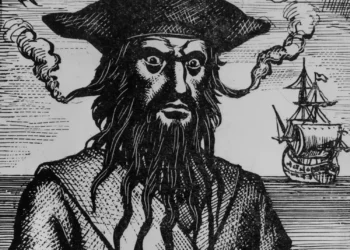In the waters off Madagascar’s northeast coast, archaeologists say they have uncovered the final resting place of a ship plundered in one of history’s most dramatic pirate raids. The wreck, they believe, is that of the Nossa Senhora do Cabo—a Portuguese vessel overtaken in 1721 by the infamous pirate Olivier “The Buzzard” Levasseur.
More than three centuries after its capture, the remnants of the ship lie beneath the waves near Nosy Boraha, an island once known as Île Sainte-Marie, a notorious pirate haven during the “Golden Age of Piracy.”
The discovery is the result of 16 years of painstaking research by American archaeologists Brandon Clifford and Mark Agostini from the Center for Historic Shipwreck Preservation. Their findings, recently published in Wreckwatch magazine, have not yet been peer-reviewed. Still, they present a compelling case based on sonar scans, historical records, and over 3,300 recovered artifacts.

A Forgotten Battle on the High Seas
The Nossa Senhora do Cabo, or “Our Lady of the Cape,” set sail from Goa, India, in early 1721. Aboard were two of the most powerful figures in Portugal’s Indian empire: the outgoing viceroy and the Archbishop of Goa. Below decks were more than 200 enslaved people from Mozambique, pressed into the service of the empire and now caught in a maritime nightmare.
It was a pretty loaded ship, in more ways than one. Except the ship never reached its destination. On April 8, 1721, it was ambushed near Réunion Island by a fleet of pirate ships.
At the helm of their pirates was Olivier Levasseur, a man so feared he earned the nickname “The Buzzard.” The luck favored the pirates. The Cabo was already reeling from a storm. Much of its artillery had been tossed overboard in a desperate bid to stay afloat. Resistance was futile, the attackers could not be stopped.
The pirates swarmed the vessel and took control. The ship’s haul was “an eye watering treasure, even by pirate standards,” Clifford and Agostini wrote. They estimate the loot, by today’s standards, would exceed $138 million. Historical records list gold and silver bars, coins, silks, and more than 400 gemstones, including 110 diamonds and 250 emeralds.
The Clues Beneath the Waves
The remains of the Nossa Senhora do Cabo were discovered in a quiet harbor near Nosy Boraha, about 650 kilometers (400 miles) west of the ambush site. Clifford and Agostini used sonar and remote sensing to map the seafloor, identifying a distinctive ballast pile matching the ship’s profile. Nearby, they found clusters of artifacts strewn across the site.

Among them: finely carved religious figurines and devotional items made of wood and ivory. One statuette depicts the Virgin Mary. Another piece—a small plaque—bears the letters “INRI,” short for “Jesus of Nazareth, King of the Jews.” These, the researchers believe, were crafted in Goa and meant for Lisbon’s cathedrals.
Also recovered were Arabic-inscribed gold coins, delicate porcelain shards, and fragments of luxury pottery. Many of these pieces remain buried beneath layers of sand and silt. “Ideally, future fieldwork will lead to more analysis of the many wrecks there,” Agostini told Live Science.
Île Sainte-Marie was no random hideout. During the 18th century, it was a lawless crossroads in the Indian Ocean—favored by pirates for its calm waters and isolation from colonial authority. Dozens of pirate crews made it their base, exploiting its proximity to shipping lanes and its safe anchorages.
Clifford said records suggest that between seven and ten ships—either pirate vessels or captured prizes—were scuttled or wrecked nearby. At least four lie in this harbor alone.
For centuries, the island’s buried history went largely ignored. “The site has historically been overlooked by researchers,” Agostini noted, “and so there’s ample room for more discoveries that give us a glimpse into the past.”

Yet amid the gold and glamour, unanswered questions remain. The Portuguese viceroy was eventually ransomed and returned to Lisbon. But the fate of the archbishop is unknown. So too is the fate of the enslaved people locked below deck. Their lives, like so many others in the age of empire, lost at sea. History mostly remembers the “big” people, while the lives of common folk are often ignored.
The identification of the Nossa Senhora do Cabo reframes how we think about the Indian Ocean’s colonial and pirate past—about the fragile line between empire and rebellion, devotion and plunder, wealth and human suffering.
As Clifford and Agostini’s study circulates among historians and archaeologists, it may prompt new questions and, perhaps, new expeditions.
Because under the sand and silt of Madagascar’s pirate shores, history still waits—lost, but not forgotten.






